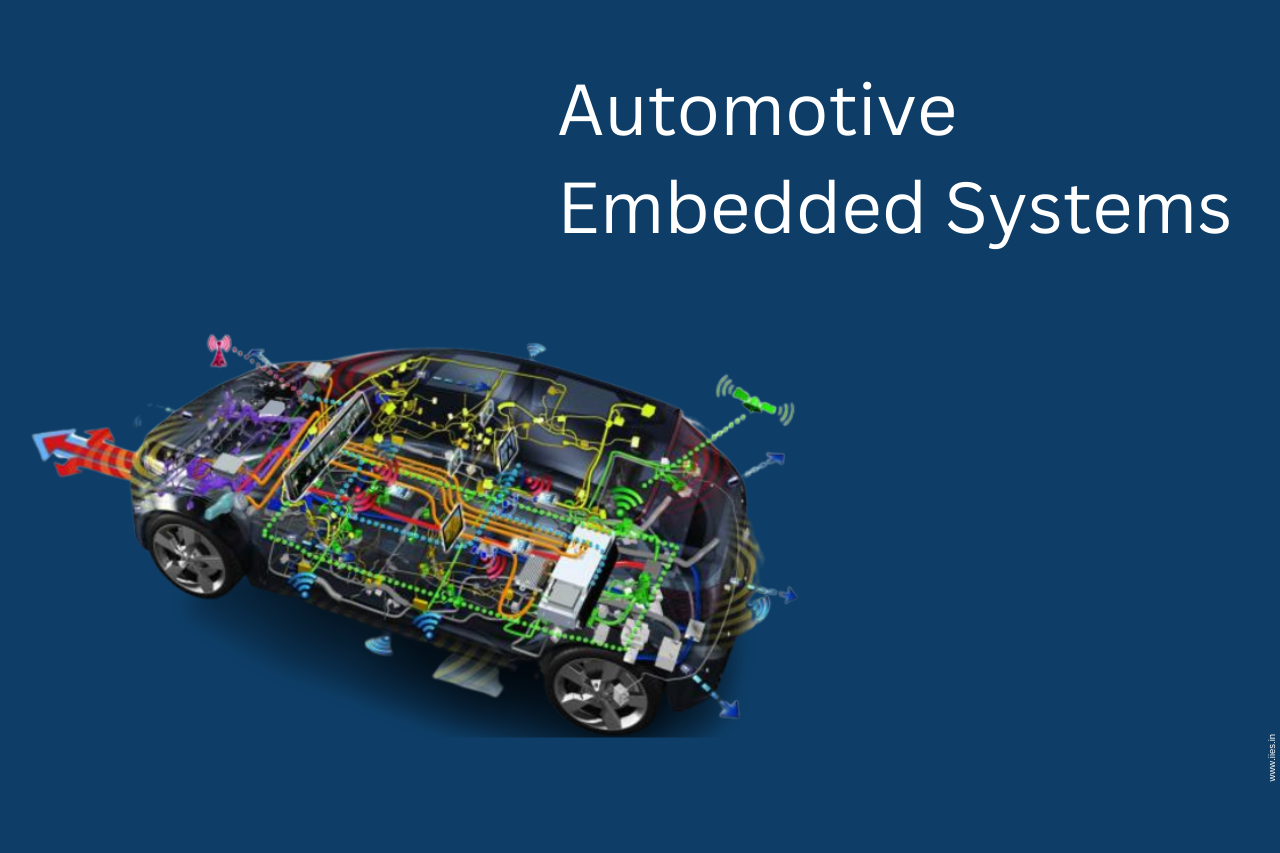The Automotive Embedded Systems Course at IIES is designed for learners who wish to explore how electronics, programming, and automation power modern vehicles. The automotive domain represents one of the world’s largest and fastest-growing industries, driving economic development and technological advancement across nations.
In this course, students will gain practical knowledge of automotive embedded concepts, CAN communication protocols, and microcontroller applications—all essential for understanding real-time automotive systems.
This module is part of the PG Diploma in Embedded Systems Design &Development

Course Name: “Crash Course on Automotive Embedded Systems”
Duration – 6 Days
No. Of hours per day – 4 hours
Total No of hours – 24
Pre- and post-assessment – YES
Project – YES
Course completion certificate – YES
Pre-Requisite – Knowledge of microcontrollers, C programming & Basic electronics (Digital & Analog)
Automotive Embedded Systems are specialized computing systems that control multiple vehicle operations from engine management and braking systems to advanced driver assistance systems (ADAS) and infotainment units.
This crash course focuses on the foundations of system theory, control design, and multirate system theory. Through this learning path, participants will understand how safe, robust, and efficient embedded control systems are engineered for modern automobiles.
Hands-on experience is provided using industry tools like MATLAB, Simulink, and dSPACE Controllers, ensuring a balance between theoretical understanding and practical application. Students will also be introduced to international safety and regulatory standards such as ISO 26262, which governs functional safety in automotive system design.
By completing this course, learners will be prepared to contribute to next-generation automotive innovations from electric vehicles (EVs) to autonomous driving technologies.
Vehicle Control and Communication Systems
Choosing the Automotive Embedded Systems Course at IIES offers several long-term benefits:
✔ Job Security:
The automotive industry remains a critical pillar of the global economy, ensuring stable career prospects.
✔ Career Growth:
Opportunities exist in engineering, design, R&D, manufacturing, and testing, providing vast scope for advancement.
✔ Technical Skill Development:
Students gain hands-on expertise in programming, electronics, and system design skills in high demand worldwide.
✔ High Income Potential:
Automotive engineers and embedded system specialists earn competitive salaries, often accompanied by excellent benefits.
✔ Exposure to Cutting-Edge Technology:
Work with emerging innovations such as autonomous vehicles, IoT integration, and EV systems.
✔ Global Career Opportunities:
The automotive industry operates on a global scale, creating diverse professional pathways across continents.
✔ Real-World Impact:
Professionals directly influence vehicle safety, sustainability, and performance, shaping the future of mobility.
After completing the Automotive Embedded Systems Crash Course, learners can pursue rewarding roles in the automotive and embedded engineering domains.
4. Autonomous Driving Engineer
Builds systems that enable driverless technology using sensors, AI, and machine learning.
Average Salary: ₹15–25 LPA
Embedded systems are used across all modern vehicle functionalities. Key applications include:
Join the Automotive Embedded Systems Course at IIES and build the expertise needed to thrive in the evolving automotive landscape. Learn the systems that drive the vehicles of tomorrow today.
The term “automotive” refers to any type of self-propelled vehicle and is derived from the Greek autos (self) and the Latin motivus (of motion). Elmer Sperry (1860–1930), the term’s inventor, first used it to describe automobiles in 1898.
A self-propelled motor vehicle intended for on-land passenger transportation is referred to as an automobile. Typically, it has a four-wheeled design and an internal combustion engine that is most frequently powered by petrol, a liquid petroleum product.
Airbags, seat belts, and anti-lock brake systems are just a few of the safety components of a car that are controlled and monitored by embedded systems. In the case of a collision, these systems cooperate to keep the driver and passenger’s safe.
Many different technologies in a variety of industries use embedded systems. Several instances include: Automobiles. In most modern cars, there are numerous computers—up to 100, sometimes—or embedded systems that are used to carry out various functions.
An automobile or other motor vehicle’s electrical systems or subsystems are controlled by an embedded system called an electronic control unit (ECU), often referred to as an electronic control module (ECM).
Today, a typical car has more than 40 ECUs, and a luxury car may have more than 150. ECUs are used in many different automotive systems, including ADAS, infotainment, body control, and comfort systems.
Leading Automotive Embedded System Market Players
Robert Bosch
Panasonic
Toshiba
Continental AG
Verizon
Denso
Mitsubishi Electric
Intel
Texas Instruments
Harman International
NXP
Nvidia
Sierra Wireless
Microchip Technology
Johnson Electric
Renesas Electronics
Delphi Automotive
The engine, fuel system, gearbox, electrical system, cooling, and lubrication system, and chassis, which include the suspension system, braking system, wheels, and tires, and body, are the key systems of a car.
Although “automobile” and “automotive” are sometimes used interchangeably, their definitions are not necessarily the same. An automobile is a four-wheeled vehicle used for transportation, while the term “automotive” can refer to any motor vehicle.
Engine:- The internal combustion engine is the beating heart and soul of your car. The timing chain, camshaft, crankshaft, spark plugs, cylinder heads, valves, and pistons are some of the components found in the engine block.
Transmission:- The gearbox, which is a gearbox full of gears and gear trains, efficiently utilizes the torque of the engine to change ratios and propel the vehicle.
Battery:- The battery provides the electricity required to power the electrical systems in your car. Your automobile won’t run without a battery.
Alternator:- As a component of the electrical system, the alternator powers the electrical system while your automobile is operating and charges the battery.
Radiator:- By eliminating heat from coolant before it is circulated back through the engine, the radiator aids in keeping the engine cool.
Brakes:- Your brakes are one of the most crucial safety features on your car and are located on all four wheels. Both the front and rear wheels have disc brakes, which are equipped with calipers and brake pads. On the back wheels of some cars, you might find drum brakes with brake shoes and wheel cylinders.
Indian Institute of Embedded Systems – IIES